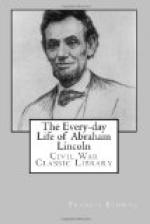A spirit of restlessness, a love of adventure, a longing for new scenes, and possibly the hope of improving his condition, led Thomas Lincoln to abandon the Rock Spring farm, in the fall of 1816, and begin life over again in the wilds of southern Indiana. The way thither lay through unbroken country and was beset with difficulties. Often the travellers were obliged to cut their road as they went. With the resolution of pioneers, however, they began the journey. At the end of several days they had gone but eighteen miles. Abraham Lincoln was then but seven years old, but was already accustomed to the use of axe and gun. He lent a willing hand, and bore his share in the labor and fatigue connected with the difficult journey. In after years he said that he had never passed through a more trying experience than when he went from Thompson’s Ferry to Spencer County, Indiana. On arriving, a shanty for immediate use was hastily erected. Three sides were enclosed, the fourth remaining open. This served as a home for several months, when a more comfortable cabin was built. On the eighteenth of October, 1817, Thomas Lincoln entered a quarter-section of government land eighteen miles north of the Ohio river and about a mile and a half from the present village of Gentryville. About a year later they were followed by the family of Thomas and Betsy Sparrow, relatives of Mrs. Lincoln and old-time neighbors on the Rock Spring farm in Kentucky. Dennis Hanks, a member of the Sparrow household and cousin of Abraham Lincoln, came also. He has furnished some recollections of the President’s boyhood which are well worth recording. “Uncle Dennis,” as he was familiarly called, was himself a striking character, a man of original manners and racy conversation. A sketch of him as he appeared to an observer in his later days is thus given: “Uncle Dennis is a typical Kentuckian, born in Hardin County in 1799. His face is sun-bronzed and ploughed with the furrows of time, but he has a resolute mouth, a firm grip of the jaws, and a broad forehead above a pair of piercing eyes. The eyes seem out of place in the weary, faded face, but they glow and flash like two diamond sparks set in ridges of dull gold. The face is a serious one, but the play of light in the eyes, unquenchable by time, betrays a nature of sunshine and elate with life. A glance at the profile shows a face strikingly Lincoln-like,—prominent cheek bones, temple, nose, and chin; but best of all is that twinkling drollery in the eye that flashed in the White House during the dark days of the Civil War.”
Uncle Dennis’s recollections go back to the birth of Abraham Lincoln. To use his own words: “I rikkilect I run all the way, over two miles, to see Nancy Hanks’s boy baby. Her name was Nancy Hanks before she married Thomas Lincoln. ’Twas common for connections to gather in them days to see new babies. I held the wee one a minute. I was ten years old, and it tickled me to hold the pulpy, red little Lincoln. The family




